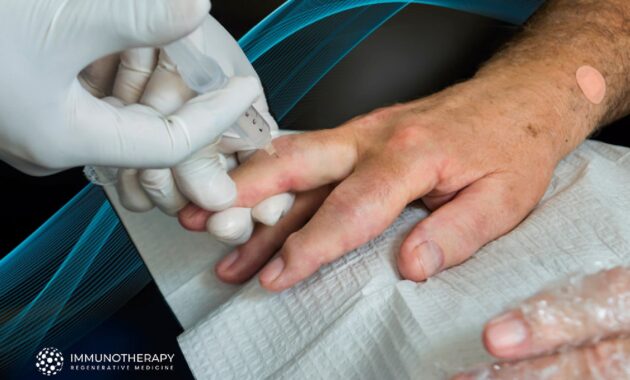Regenerative medicine to treat joint problems offers a new ray of hope to patients with osteoarthritis. An expert explains how it works.
As of now, Osteoarthritis (OA) is primarily viewed as an irreversible condition, leading to progressive joint damage. Current treatments focus on managing symptoms and improving joint function, but the advent of regenerative medicine offers a promising horizon for more therapeutic approaches to this pervasive condition.
According to Dr. Ernesto Romero, founder of Immunotherapy Regenerative Medicine in Mexico, regenerative medicine is now an alternative treatment for OA and other rheumatic diseases. It gives patients the best option to slow the disorder’s progression and improve their quality of life.
How Has OA Traditionally Been Treated?
OA has historically been managed through a multifaceted approach to reduce pain, maintain or improve joint mobility, and minimize functional impairment. The cornerstone of traditional treatment for OA includes a combination of medications, lifestyle modifications, and physical interventions.
The primary aim of medication in OA treatment is to alleviate pain and manage symptoms. Over-the-counter pain relievers like acetaminophen are often the first line of defense for mild OA pain. For more significant pain or inflammation, Nonsteroidal Anti-Inflammatory Drugs (NSAIDs), such as ibuprofen and naproxen, are commonly prescribed.
Also Read

Lifestyle modifications are complementing oral medications. Weight management is crucial in this scenario, as excess weight can increase the strain on weight-bearing joints, causing pain and accelerating cartilage wear. A balanced diet, supplemented with omega-3 fatty acids, is also recommended to maintain overall health and reduce inflammation. Low-impact exercises with flexibility exercises and stretching are also seen to strengthen the muscles around the joints, improving stability and reducing the burden on the joint.
For those who are hesitant to do physical exercises independently, some resort to physical therapy or tailored exercise programs designed by physical therapists. These help patients maintain joint flexibility, strengthen the muscles surrounding the joints, and enhance overall mobility. In severe cases of OA, where other treatments have failed to provide relief, surgical interventions like joint replacement surgery may be considered.

Healthshots Inner Circle An exclusive wellness community for women
JOIN NOW
For Dr. Romero, amidst these traditional interventions, regenerative medicine’s abilities redefine the approach to OA and other joint degradation, giving new hope to patients whose long-term well-being is affected by the condition.
Select Topics of your interest and let us customize your feed.
PERSONALISE NOW
The Science of Regenerative Medicine
The use of regenerative medicine, particularly in OA, marks a significant departure from traditional pain management methods, focusing instead on healing and tissue regeneration. At the heart of this approach lies the principle of using the body’s mechanisms for healing and repair.
Dr. Romero explains that by harnessing stem cells’ benefits, they are not just addressing the symptoms of joint pain but are actively promoting the regeneration of damaged tissues. This approach is pivotal in conditions like OA, where the degradation of joint cartilage leads to pain and reduced mobility.
Two types of regenerative intra-articular injection therapies are central to regenerative OA treatment: PRP (Platelet-rich plasma) and MSC (Mesenchymal stem cells). According to Dr. Romero, PRP therapy utilizes the patient’s blood, enriched with platelets, to promote healing in injured tissues. He adds, “With PRP, the plasma injected supplies the affected area with the factors that help them and cells to regenerate.”
On the other hand, MSC joint treatment involves the injection of MSC directly into the affected joint. MSCs are a type of multipotent stem cell capable of differentiating into various cell types, including bone, cartilage, muscle, and fat cells, harvested from tissues like bone marrow or fat. MSCs are primarily valued for repairing and regenerating damaged tissues in regenerative medicine.
“MSC treatment goes a step further,” Dr. Romero explains. “When injected into a damaged area, they can transform into the required cell type, reduce inflammation through their immunomodulatory effects, and promote healing by secreting growth factors.”
For Dr. Romero, with a focus on healing and tissue repair, both regenerative medicine therapies chart a new course in treating OA, a leap from the traditional method that advances the treatment of joint diseases and offers patients effective alternatives.
A Leader in Regenerative Medicine
Despite this new alternative, Dr. Romero recognizes that the effectiveness of treatments, including regenerative therapies, varies on a case-by-case basis. He acknowledges that every patient’s condition is unique, influenced by a myriad of factors such as their medical history, the severity of their condition, and individual biological responses. This is where a personalized approach to regenerative medicine is necessary.
This understanding forms the foundation of Dr. Romero’s Immunotherapy Regenerative Medicine clinic at the heart of Puerto Vallarta, Mexico. The clinic focuses on tissue regeneration and repair, addressing various conditions, including autoimmune, neurological, and musculoskeletal disorders.
With Dr. Romero’s over 20 years of experience in stem cell research and therapy, he ensures that high-level personalized stem cell treatment is implemented through meticulous patient evaluation and monitoring to operate on the highest safety standards and maximize the potential benefits of regenerative therapies.
The Demand for Regenerative Medicine
As the world moves towards the future, the role of clinics like Immunotherapy Regenerative Medicine in shaping the healthcare landscape becomes increasingly significant. With forecasts indicating a rise in OA prevalence due to aging populations and lifestyle factors, such innovative treatments could offer a much-needed solution.
Dr. Romero reflects, “We are welcoming a new era in medicine. Our goal is to offer not just hope for those suffering from OA conditions but for other traditionally hard-to-treat conditions as well.”
#Treating #Joint #Problems #Modern #Age #Regenerative #Medicine #Paves
